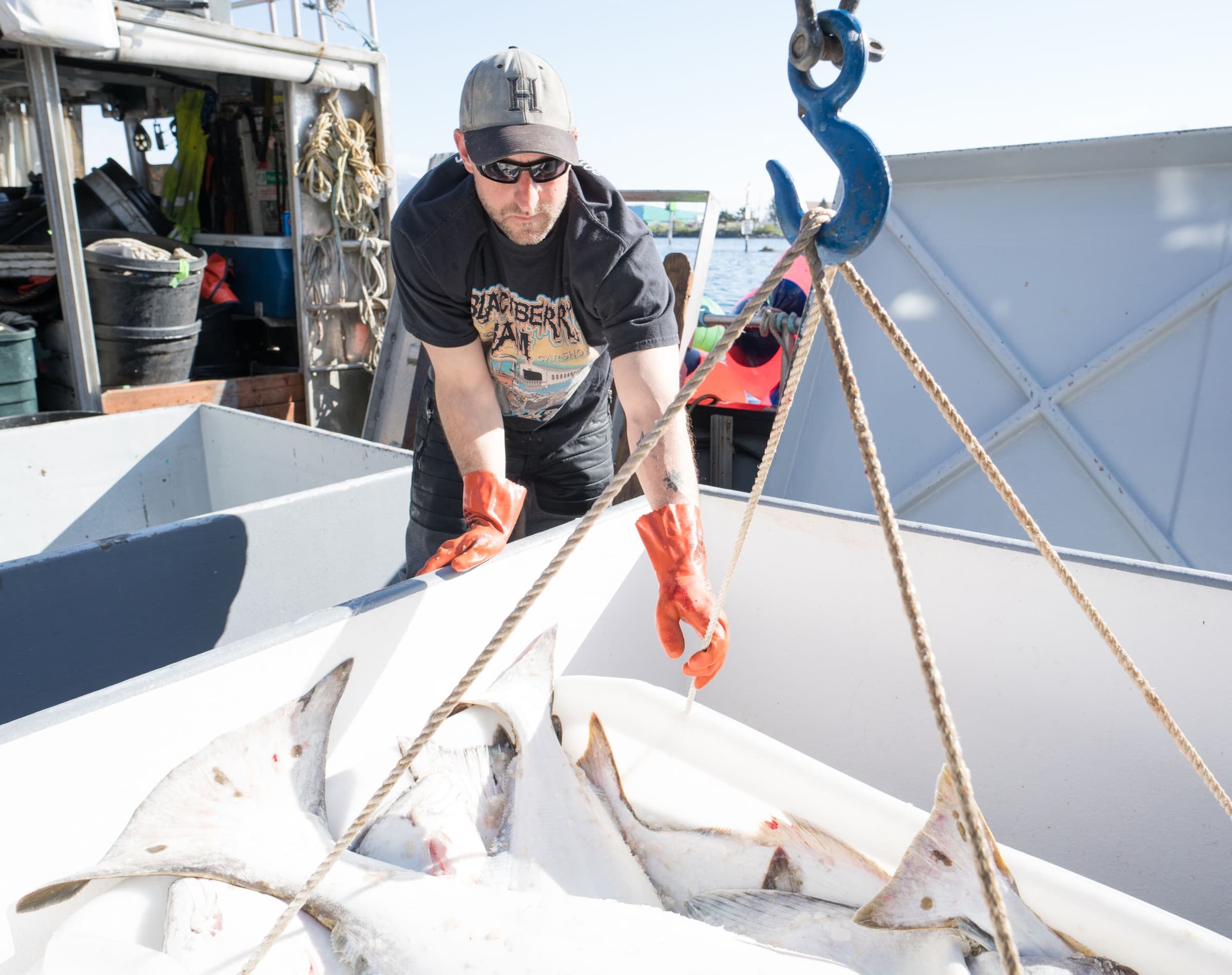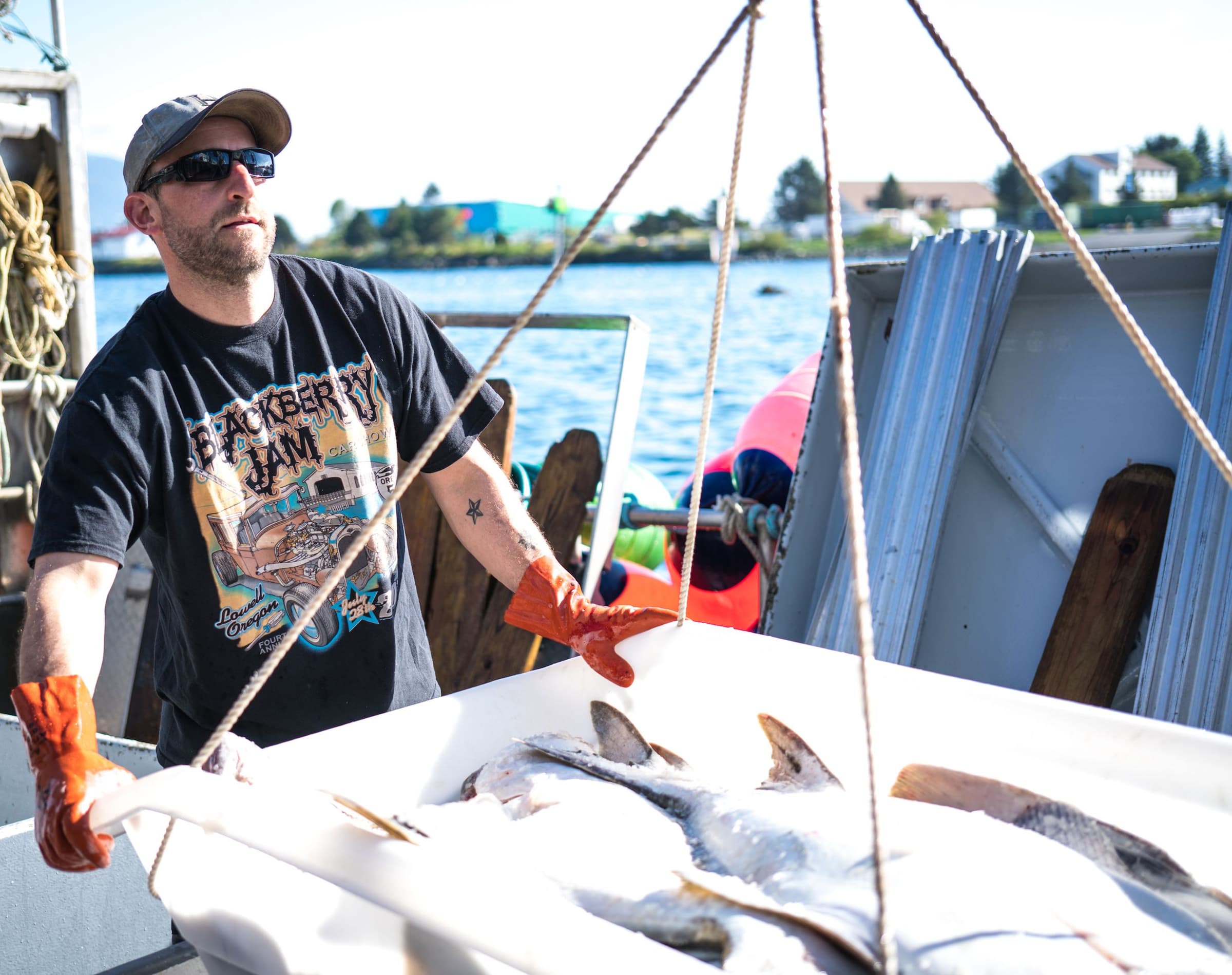
There is nothing quite like summertime in Alaska. Fireweed blooms, salmonberries swell, and fishing communities are buzzing with activity. Commercial fishing is a year-round activity, but nothing matches the explosion of energy of the summer salmon runs.
Fisherman Stu Weathers knows all about how work changes when the fish are biting. Fish don’t wait for you to be ready, forcing crews to pack as much work into a small timeframe as possible. “4 a.m. to midnight, every day,” Stu says.
When the fishing is that intense, crews sacrifice sleep in order to fill their fish holds. But, Stu says, it’s important to take the time to do things right. “You always want to do things as fast as possible, and we’re still worried about getting done quickly, but we won’t sacrifice quality for speed.”

Whether he’s caught salmon, halibut, or sablefish, every fish passes through three stages. First, a fisherman hauls them aboard and removes them from the gear. Fishermen then place the fish in a check tote, where the fish are chilled and bled to preserve freshness. Next, they’re moved down into the fish hold. Here they are kept cold until they are unloaded at the dock or a fish tender arrives to pick them up for transport back to the fish plant for processing into the portions and products that fill your box every month.
“Everybody just wants to go, go, go, when you’re out fishing,” Stu says. Speed is important, but quality is what sets Sitka Seafood Market apart from other wild seafood sources. Stu has been with us since the beginning. “When I first started doing this, [co-founder] Marsh [Skeele] used to work for me and he’s the one who really sold me on the business model: we are gonna have better fish than everyone else.”

THE SCIENCE OF QUALITY
Product quality is so important to our success that we shipped a box of Stu’s halibut to Oregon State University’s Food Innovation Center to see how it measured up to our competitors in a scientific sensory study. We didn’t inform Stu or our staff ahead of time. We wanted OSU to receive the same product that you get in your box. Ann Colonna, the sensory program director at OSU, recruited 108 seafood lovers from the Portland, Oregon area and developed a questionnaire that would gauge their impression of the fish’s quality. It was a lot of data, but the results were clear in the end.“
"We had an amazing response,” Ann says. “I’ve never had a test in my 20-year career that so many people said would change their buying habits.” In a blind taste test on measures of flavor, texture, and appearance, Stu’s halibut prevailed over samples provided by four competitors. Ann takes pride in what OSU has accomplished by demonstrating how different handling techniques and technology make an impact on the final product. “We’ve actually done several seafood projects dating back to 2016,” Ann says. In a study funded by the National Fish and Wildlife Foundation, the Food Innovation Center upended conventional knowledge about seafood quality. “The frozen product was not only liked as well as the fresh, but in some cases it was actually statistically preferred to the fresh product,” Ann says. “So it made sense for us to continue with this project.”

Ann had plenty of help from chef Hank Sawtelle, who had the assignment of cooking hundreds of samples under uniform conditions. “It was an exciting event for me to participate in because I have a science background and an engineering background and it was fun to bring my cooking skills to this kind of event and produce useful results,” Hank says.
Hank can clock differences in quality even before he gets his hands on a piece of seafood. “The quality of the portions that were coming out of these direct-to-doorstep competitor packages were not great in my opinion as a chef.” Improper storage and handling can all degrade quality, Hank says. “The flesh had lost a lot of liquid, the color was pretty opaque, which isn’t what you want to see in a fresh fish. And in the cooking process that suspicion was borne out in the texture of the finished product being pretty stiff and rubbery and on the drier side.”
“The Sitka [Seafood Market] samples were, in my opinion, just a lot nicer to work with: nice, translucent flesh, not a lot of water loss, no smell whatsoever other than a briny ocean smell."
Hank goes on, “All of that is ticking the boxes of what I would want to see for a fresh or frozen product that I would purchase.”

I shared the results of the study with Stu, reaching him on the phone during the slow season late last year. I asked him what he thought of the results. “Honestly, when I saw it, it was awesome,” he tells me. “It just proves that all the measures we take to ensure that we have such high quality is working, and it gives me a sense of pride.”
Stu says that if his fish can impress seafood lovers in Portland, he is doing something right. “I always say we’re seafood snobs here in Sitka, but they have high-end fish places in Portland, they are seafood eaters and they know quality.”
The purpose of the study was to confirm that the efforts of fishermen like Stu Weathers make their way into the final product. Although these results affirm our standards, we are always looking to improve our practices and use of technology so you get the best-tasting wild seafood possible. Your feedback is also crucial to our mission to build a better seafood system.

Our Salmon Support Team gives us important data that informs how we source and handle our seafood. Fishermen like Stu are also watching the photos you share on the Sitka Salmonsharesians Facebook group. “I love seeing the people that get to enjoy my fish,” Stu says. “When members post pictures of my fish on the Salmonsharesians page, when they have a nice piece of halibut or black cod that I caught, it’s pretty cool and makes me proud.”

